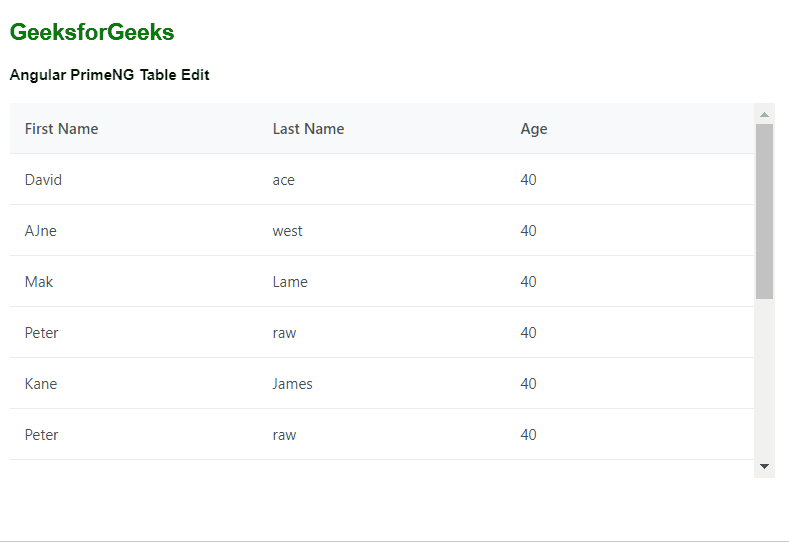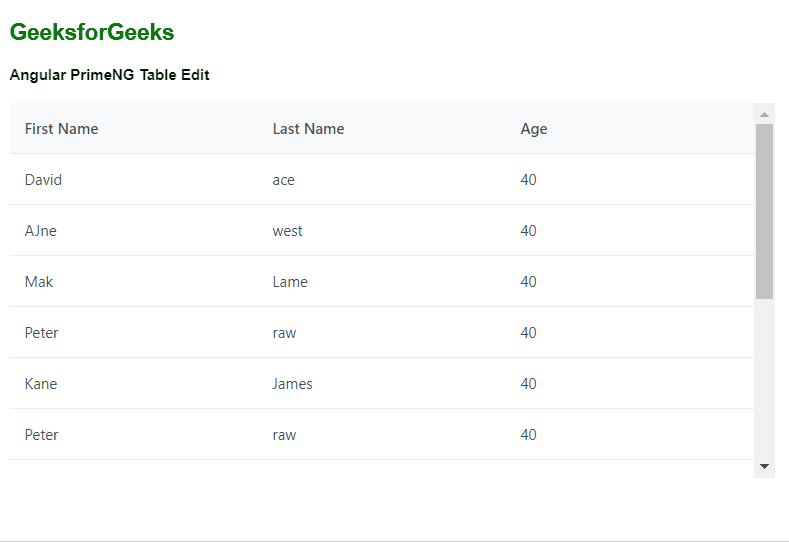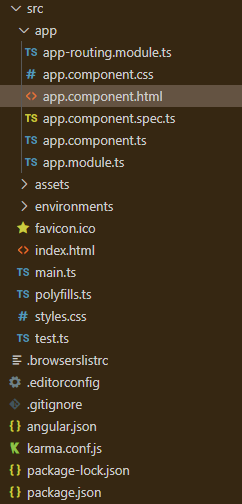Angular PrimeNG表的动态列
Angular PrimeNG是一个开源框架,拥有丰富的原生Angular UI组件,可用于出色的造型,这个框架用于制作响应式网站,非常方便。这篇文章将向我们展示如何在Angular PrimeNG中使用表动态列。
Angular PrimeNG Table Dynamic Columns是用来动态设置和渲染Table组件的列的。有两种方法来呈现动态列,使用组件范围内的cols属性并将其绑定到ngFor指令,另一种方法是将cols数组绑定到columns属性,然后定义一个模板变量来访问你的模板。
语法:
- 在app.component.ts文件中。
this.cols = [
{
field: 'fieldName1',
header: 'headerName1'
},
{
field: 'fieldName2',
header: 'headerName2'
},
];
- 在app.component.html文件中。
<p-table>
<ng-template pTemplate="header" let-columns>
<tr>
<th *ngFor="let col of columns">
{{ col.header }}
</th>
</tr>
</ng-template>
</p - table >
创建Angular应用程序和模块安装。
第1步:使用以下命令创建一个Angular应用程序。
ng new appname
第2步:创建你的项目文件夹即appname后,使用以下命令移动到它。
cd appname
第3步在你给定的目录中安装PrimeNG。
npm install primeng --save
npm install primeicons --save
项目结构:它将看起来像如下。
例子1:下面是一个简单的例子,演示Angular PrimeNG表动态列的使用。
- app.component.html
<h2 style="color: green">
GeeksforGeeks
</h2>
<h4>
Angular PrimeNG Table Dynamic Columns
</h4>
<p-table
#myTab
[value]="tableData"
[scrollable]="true"
scrollHeight="400px"
[columns]="cols"
>
<ng-template pTemplate="header"
let-columns>
<tr>
<th *ngFor="let col of columns">
{{ col.header }}
</th>
</tr>
</ng-template>
<ng-template pTemplate="body"
let-people>
<tr>
<td>
{{ people.firstname }}
</td>
<td>
{{ people.lastname }}
</td>
<td>
{{ people.age }}
</td>
</tr>
</ng-template>
</p-table>
- app.component.ts
import { Component } from '@angular/core';
interface People {
firstname?: string;
lastname?: string;
age?: string;
}
@Component({
selector: 'app-root',
templateUrl: './app.component.html',
})
export class AppComponent {
tableData: People[] = [];
cols: any[] = [];
constructor() { }
ngOnInit() {
this.cols = [
{
field: 'firstname',
header: 'First Name'
},
{
field: 'lastname',
header: 'Last Name'
},
{
field: 'age',
header: 'Age'
},
];
this.tableData = [
{
firstname: 'David',
lastname: 'ace',
age: '40',
},
{
firstname: 'AJne',
lastname: 'west',
age: '40',
},
{
firstname: 'Mak',
lastname: 'Lame',
age: '40',
},
{
firstname: 'Peter',
lastname: 'raw',
age: '40',
},
{
firstname: 'Kane',
lastname: 'James',
age: '40',
},
{
firstname: 'Peter',
lastname: 'raw',
age: '40',
},
{
firstname: 'Kane',
lastname: 'James',
age: '40',
},
{
firstname: 'Peter',
lastname: 'raw',
age: '40',
},
{
firstname: 'Kane',
lastname: 'James',
age: '40',
},
{
firstname: 'Peter',
lastname: 'raw',
age: '40',
},
{
firstname: 'Kane',
lastname: 'James',
age: '40',
},
{
firstname: 'Peter',
lastname: 'raw',
age: '40',
},
{
firstname: 'Kane',
lastname: 'James',
age: '40',
},
];
}
}
- app.module.ts
import { NgModule } from '@angular/core';
import { BrowserModule } from '@angular/platform-browser';
import { FormsModule } from '@angular/forms';
import { HttpClientModule } from '@angular/common/http';
import { BrowserAnimationsModule } from '@angular/platform-browser/animations';
import { AppComponent } from './app.component';
import { ProductService } from './productservice';
import { TableModule } from 'primeng/table';
@NgModule({
imports: [
BrowserModule,
BrowserAnimationsModule,
TableModule,
HttpClientModule,
FormsModule,
],
declarations: [AppComponent],
bootstrap: [AppComponent],
providers: [ProductService],
})
export class AppModule { }
输出:

例子2:下面是另一个例子,演示Angular PrimeNG表动态列的使用。在这个例子中,我们使用app.component.ts组件的cols属性来动态地渲染列。
- app.component.html
<h2 style="color: green">
GeeksforGeeks
</h2>
<h4>
Angular PrimeNG Table Dynamic Columns
</h4>
<p-table
#myTab
[value]="tableData"
[scrollable]="true"
scrollHeight="400px"
>
<ng-template pTemplate="header">
<tr>
<th *ngFor="let col of cols">
{{ col.header }}
</th>
</tr>
</ng-template>
<ng-template pTemplate="body"
let-people>
<tr>
<td>
{{ people.firstname }}
</td>
<td>
{{ people.lastname }}
</td>
<td>
{{ people.age }}
</td>
</tr>
</ng-template>
</p-table>
- app.component.ts
import { Component } from '@angular/core';
interface People {
firstname?: string;
lastname?: string;
age?: string;
}
@Component({
selector: 'app-root',
templateUrl: './app.component.html',
})
export class AppComponent {
tableData: People[] = [];
cols: any[] = [];
constructor() { }
ngOnInit() {
this.cols = [
{
field: 'firstname',
header: 'First Name'
},
{
field: 'lastname',
header: 'Last Name'
},
{
field: 'age',
header: 'Age'
},
];
this.tableData = [
{
firstname: 'David',
lastname: 'ace',
age: '40',
},
{
firstname: 'AJne',
lastname: 'west',
age: '40',
},
{
firstname: 'Mak',
lastname: 'Lame',
age: '40',
},
{
firstname: 'Peter',
lastname: 'raw',
age: '40',
},
{
firstname: 'Kane',
lastname: 'James',
age: '40',
},
{
firstname: 'Peter',
lastname: 'raw',
age: '40',
},
{
firstname: 'Kane',
lastname: 'James',
age: '40',
},
{
firstname: 'Peter',
lastname: 'raw',
age: '40',
},
{
firstname: 'Kane',
lastname: 'James',
age: '40',
},
{
firstname: 'Peter',
lastname: 'raw',
age: '40',
},
{
firstname: 'Kane',
lastname: 'James',
age: '40',
},
{
firstname: 'Peter',
lastname: 'raw',
age: '40',
},
{
firstname: 'Kane',
lastname: 'James',
age: '40',
},
];
}
}
- app.module.ts
import { NgModule } from '@angular/core';
import { BrowserModule } from '@angular/platform-browser';
import { FormsModule } from '@angular/forms';
import { HttpClientModule } from '@angular/common/http';
import { BrowserAnimationsModule } from '@angular/platform-browser/animations';
import { AppComponent } from './app.component';
import { ProductService } from './productservice';
import { TableModule } from 'primeng/table';
@NgModule({
imports: [
BrowserModule,
BrowserAnimationsModule,
TableModule,
HttpClientModule,
FormsModule,
],
declarations: [AppComponent],
bootstrap: [AppComponent],
providers: [ProductService],
})
export class AppModule { }
输出:

 极客教程
极客教程